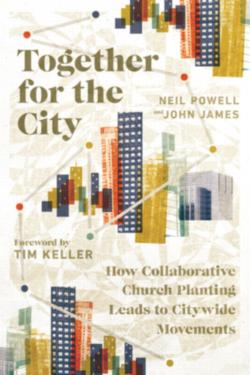Together for the City
by Neil Powell and John James
IVP 2019
Wouldn’t it be great if the body of Christ in a particular area was a bit more coordinated! If our deaneries were more purposeful, if our minister’s fraternals were more strategic? Wouldn’t it be great if we could hear of the success of a church down the road or a church plant in the suburb along without an ugly defensiveness rising within us?
If you’ve got a fire in your belly to see more churches grow and be planted in your region; if you’ve got the uncomfortable sense that your church floats a foot above your locality and your people aren’t burdened to see your specific town/suburb/city reached for Jesus; and if you’ve got an inkling that this is a project that is going to need a vision bigger than any one parish, or even (perish the thought) any one denomination, then this is the book for you.
Together for the City is a book best read with a group of like-hearted pastors. It claims to be provocative. I found it provocative in the way that the smell of fresh-baked croissants in my kitchen provokes me out of my bedroom in the morning.
Neil Powell and John James both share that rarest of characteristics – people who can both do something well and explain how they did it. The book, in part, gives the narrative of how 2020Birmingham came to be with their vision to see 20 new churches planted by 2020, now extended to 30 planted by 2030 and 100 in their lifetime. But in laying out this story, they’re also offering a guidebook for how we might establish similar networks in our context to attempt the gospel goals that we couldn’t achieve working on our own.
The book breaks up into three sections, the first paints a vivid picture of the scale of the task before us, suggesting it’s akin to the Dunkirk evacuation of WW2. But rather than leaving us feeling exhausted before we’ve begun, it also suggests that the gospel not only requires, but enables collaboration across difference.
The practical meat of the book comes in the middle as they lay out a framework for the ‘how’ of collaboration using the equation: core + cause + code = collaboration. That is, although we may share a theological affinity with another church (core) that, in and of itself, is not collaboration. Collaboration comes when churches in a locality who share a gospel core also share a theological vision for what could be achieved in that area (cause) and flesh out a shared DNA (code) that energises a movement and carries it to action.
Having laid this all out, the third section offers several case-studies in the UK and abroad. It’s hard not to be excited reading this section, imagining similar partnerships and collaborations emerging in one’s own context.
It’s fair to say I came to this book suspiciously. “Are you asking me, a convinced Anglican, to give up my distinctives and plant churches with the [insert denomination I find disagreeable here] church down the road?” I protested. “I’m really busy – like Covid busy – and I’m not sure this is a good use of my time!” I complained. But at each turn I found both the argument and the narrative utterly disarming. They showed that they weren’t arguing that we plant churches together, but ‘to be together as we plant churches’ which is a masterful difference. It means that we can genuinely celebrate God doing new things in our area without experiencing threat or competitiveness. They also make the strong theological case for prioritising this work and can bear witness to how it has been life giving for pastors in collaborative partnerships around the world.
I hope there are many editions of Together for the City, and that with each the case studies section swells with stories of pastors who bravely worked together and, therefore, achieved what they couldn’t have alone for the cause of Christ in their region.
Steve Boxwell leads a church plant in Tuggeranong, Canberra